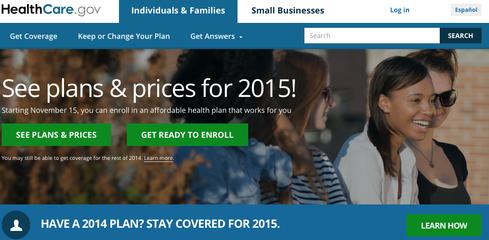ACA Open Enrollment: Showtime For Health Insurance Sites
During the next three months, consumers can sign up for health insurance during the Affordable Care Act open enrollment period. New technologies at health insurance websites aim to smooth the way.


8 Innovative Health IT Startups
8 Innovative Health IT Startups (Click image for larger view and slideshow.)
Americans will have an opportunity during the next three months to sign up for health insurance during the 2015 Obamacare open enrollment period. To prepare, health insurance websites are rolling out a number of new tools and technologies designed to reduce confusion and help consumers locate insurers.
Despite this third-party assistance, the US administration reduced by 30% the number of people it predicted would enroll in government-backed or state health insurance marketplaces over the three-month open enrollment period, which begins on November 15. Originally, the Congressional Budget Office expected 13 million people to enroll; now, they predict that between 9 million and 9.9 million will enroll, Reuters reported.
In addition, all may not run smoothly at Healthcare.gov, despite changes over the past 12 months. These included the hiring of Accenture to manage the site and back-end systems, InformationWeek wrote last month.
"Open enrollment this year will be a positive experience for the consumer," said US Health and Human Services Secretary Sylvia Burwell. But some things "will go wrong... we will have outages. We will have down time."
Healthcare.gov is not the only site using a new tech vendor.
Massachusetts' MassHealth switched to a system from hCentive, developer of Kentucky's website. Maryland turned to Deloitte, which was behind Connecticut's successful site, to replace its trouble-prone first iteration. Idaho debuted its own site, yourhealthidaho.org, with the help of GetInsured and Accenture. Others, like Nevada (which originally used Xerox) and Oregon (now suing Oracle) switched to Healthcare.gov this year after trying state-run sites. New Mexico -- which had planned to move individuals to a state-run site in 2015 -- opted to stick with the federal system for another year.
"When consumers shop for coverage, they want the kind of personalization they experience when they shop on Amazon and it suggests the best product for them. Amazon maps your personal purchase behavior and the behavior of millions of others to match you with the best fit. Americans want to be advised on the best investment for their bodies and their lives and then get on with their lives," Noah Lang, CEO of Stride Health, told InformationWeek.
In addition to the technology and integrators powering these websites, many states have invested in more call centers, navigators, and marketing to promote their services and encourage residents to sign on for insurance. Healthcare officials also are partnering with insurance brokers, agents who specialize in helping people select from among multiple insurance plans, according to the Seattle Times.
"For our sustainability, it's really important we get to those agents and brokers," Michael Marchand, communications director at state exchange Washington Healthplanfinder told the newspaper.
To help brokers, developers such as Limelight Health will soon offer mobile apps to compare plans and prepare quotes. QuotePad -- slated for release this year for iOS and Android operating systems -- is designed for small-business health insurance plans, and includes a custom, live interface with cost models, employer-sponsored health insurance options, and pricing compared across "thousands of health exchange systems at once," according to Limelight Health. The SaaS cloud-based software calculates subsidies, health reimbursement accounts (HRA), health savings accounts (HAS), and can be private-labeled, the developer said.
For individuals working alone or supporting a small or midsized business, websites including GoHealth and HealthPlans.com allow them to comparison-shop across a spectrum of insurance providers nationwide. This enrollment period, 73% of more than 1,100 consumers surveyed plan to evaluate new insurance plans, HealthPlans.com research found; that includes 63% of those who said they were "satisfied" or "very satisfied" with their current coverage.
Stride Health is authorized to sell plans from about three-dozen insurance carriers, working with large national companies and small, regional firms, said Lang. The company also teamed up with Healthcare.gov to deliver government assistance via tax subsidies like those available on the federal website, he said.
"We don't market our technology to those carriers though; we're 100% direct-to-consumer. The key is to build for the consumer, meet their needs, and speak their language. It's the path-less-traveled in healthcare in the US," said Lang. "Consumers aren't willing to download an app to buy health insurance, but they want an app-like experience. That's why we're launching a web app that looks and feels like a native app. It's a fast, seamless experience that gives consumers the experience they deserve when making a major life investment like health coverage."
Employers see a talent shortage. Job hunters see a broken hiring process. In the rush to complete projects, the industry risks rushing to an IT talent failure. Get the Talent Shortage Debate issue of InformationWeek today.
About the Author(s)
You May Also Like
How to Amplify DevOps with DevSecOps
May 22, 2024Generative AI: Use Cases and Risks in 2024
May 29, 2024Smart Service Management
June 4, 2024







